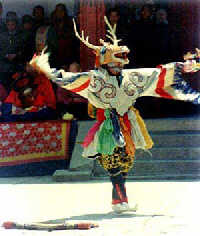|
Qamo Dance
( 2005-10-17 )
 The religious dance Qamo in Southwest China's Tibet Autonomous Region came into being during the confrontation between Buddhism and the local Bon religion (the Black Sect). The religious dance Qamo in Southwest China's Tibet Autonomous Region came into being during the confrontation between Buddhism and the local Bon religion (the Black Sect).
In the process of localizing Buddhism, Padmasambhava from Kashmir created a kind of religious dance to subdue the "evil spirits" in monasteries by giving the local Tibetan dances Buddhist interpretations. This religious dance gradually became popular as Qamo, a sorcerer's dance.
According to the Chronicles of Tibetan Kings, various kinds of animal-mime dances, divine-instrument dances, drum dances, and flower-offering ceremonial dances appeared during the reign of Songzan Gambo in the seventh century.
However, instead of absorbing the local Tibetan dances completely, Padmasambhava selected only some animal-mime dances and divine instrument dances that suited Buddhism and combined them with the ceremonial mask dance of the Bon religion. These dances and the Ox, Deer, and Dharma Protector dances, preserved to this day, trace back to the same origin.
Before the modern Sorcerer's Dance begins formally, a traditional livestock sacrificial ceremony is held. However, livestock is no longer killed since it goes against the doctrines of Buddhism. Mostly drawings are substituted.
 When the ceremony begins, suona horns are blown and drums and cymbals beaten. A group of performers playing demons walk slowly round as a prelude to the dance, followed by the Demons', Skeleton, Ox God, Deer, Guardian, and Dharma Protector dances. When the ceremony begins, suona horns are blown and drums and cymbals beaten. A group of performers playing demons walk slowly round as a prelude to the dance, followed by the Demons', Skeleton, Ox God, Deer, Guardian, and Dharma Protector dances.
Between dances Lamas put on wrestling and acrobatic bouts to entertain the spectators. Sometimes they perform stories from Buddhist scripture that bear messages to do good things in other people's interest, such as "Sacrifice Life to Save the Tiger" and "Dance of the Man of Longevity," who is believed to be generous in bestowing longevity and good fortune.
The last act is for the divine soldiers to drive away the evil spirits. With guns on their shoulders, the performers send Duoma (the leading demon, made of butter and tsampa, or roasted barley flour) to the wilderness and burn him to drive away evil for the year and pray for good fortune in the coming year.
|

